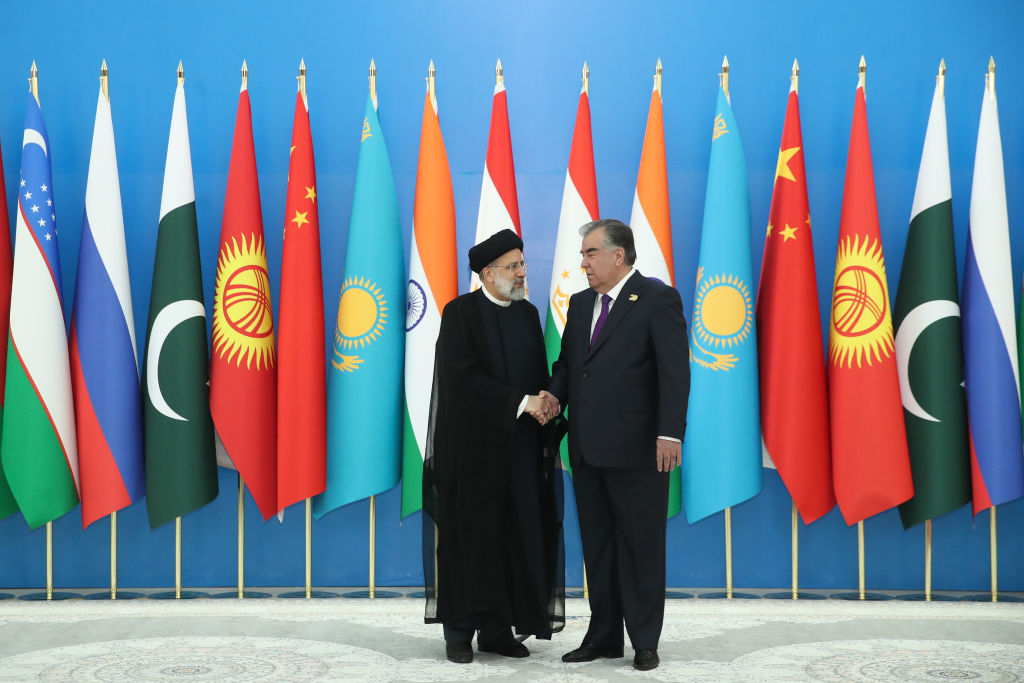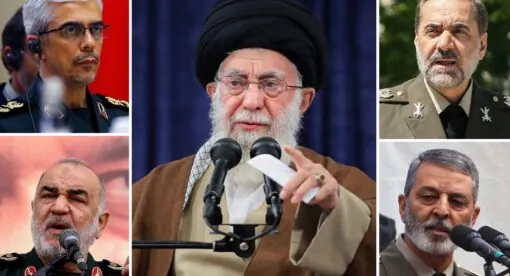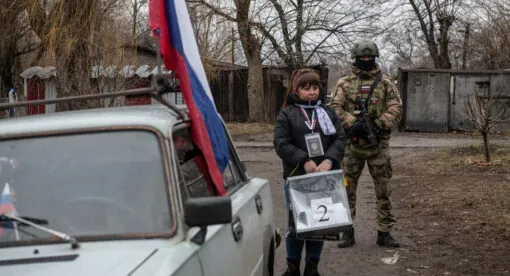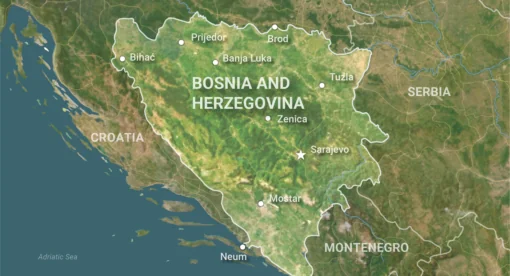Since coming to power in August, Iranian President Ebrahim Raisi’s administration has promoted a foreign policy that prioritizes relations with neighbors and with Asia. While Iran has been increasing its outreach to its Central Asian neighbors, powers like the United States and Russia are shifting their focus to competition in Eastern Europe and the Asia Pacific. The conflict in Ukraine, which has captured the world’s attention, is only amplifying this shift, allowing Iran’s extension of influence to Central Asia to fly under the radar.
Iran’s ability to project power through Afghanistan had been held in check by the presence of U.S. forces in the country, but the U.S. withdrawal and the accompanying power vacuum left Iran with new ways to exert leverage, both diplomatically and through proxy militant groups, from Afghanistan into Central Asia.
Power Vacuum in Central Asia
Iran is moving to fill a gap left by Russia, which has long been a security guarantor in Central Asia, conducting regular military exercises with its fellow Collective Security Treaty Organization (CSTO) member states including Kazakhstan, Kyrgyzstan, and Tajikistan. However, with the invasion of Ukraine and the hesitancy of Central Asian states like Kazakhstan to support Russian efforts, Moscow’s role in the region is much more in doubt. The Kremlin’s commitment of thousands of troops to Ukraine limits Russia’s ability to deal with security concerns elsewhere.
The Russian invasion also is forcing Central Asian states into an economic reckoning. In Kyrgyzstan and Tajikistan in 2020, Russian remittances accounted for 31 percent and 27 percent of their GDP, respectively. Remittances were expected to continue to grow in 2022, but since Russia’s invasion of Ukraine, revised estimates suggest they will decline by as much as 33 percent in Kyrgyzstan and 22 percent in Tajikistan. Moreover, ports in Belgium, Germany, Estonia, and the Netherlands are refusing to accept cargo from Central Asia if it is sent through Russia. This has left countries like Kazakhstan scrambling to find new transport routes as their reliance on Russia as a transit nation has left their supply chains exposed.
In addition to the security and economic fallout, Russian President Vladimir Putin’s rhetoric in the run-up to the invasion of Ukraine has been met with extreme wariness by former Soviet republics. Putin’s labeling of Ukrainian statehood as a fiction was similar to his 2014 statement that “Kazakhs never had any statehood.” This has led to fears that after Ukraine, Putin will turn to the Central Asian states to further consolidate former Soviet territories. As such, the Central Asian states have been careful not to express support for Russia’s operations. Even Kazakhstan, which only a few months ago invited Russian CSTO troops into its territory to help quell a domestic uprising, refused to recognize the independence of Luhansk and Donetsk, thereby distancing itself from Russia’s invasion – albeit without condemning it, either.
China’s role as a great power in Central Asia remains largely unchanged, but its willingness to engage with the security concerns in the region is still unclear. Its longstanding non-interference policy has caused it to focus on the economic sphere while exerting little influence in Central Asia’s security landscape. Despite its solid economic presence in countries like Kazakhstan, China has not been able to shape the outcomes of security crises like the latter country’s January uprisings.
This uncertainty opens the door to shifting power structures, including dominance by a single power, competition among regional actors, failed states, or any combination of these power structures. The increasing constraints great powers in the region are facing presents Iran with a time-sensitive opportunity to exploit the emerging power vacuum in Central Asia. Iran has proven itself to be adept at utilizing pressure and incentives to engage in power vacuums, and it is likely to employ these same tactics in any engagement with Central Asia.
Why Central Asia?
Iran is moving to exploit the power vacuum in Central Asia to advance its foreign policy priorities, which include countering sanctions through the creation of new outlets for trade, strengthening proxy forces to project influence, and ensuring regime survival by combating external threats. Iran has also built-up significant influence in neighboring Afghanistan, which provides it with additional leverage for engaging with Central Asia.

Economic Expansion
Central Asia’s potential for economic growth, as a landlocked region, is dependent on gaining access to ports in nearby countries. Iran’s ports are some of the closest to Central Asia and naturally represent a gateway for the region to engage in maritime trade. Iran also already has significant trade with Afghanistan, which sits at the heart of many prominent land-based trade routes into Central Asia. In 2018, Iran’s exports to Afghanistan were roughly $2.9 billion, more than double Pakistan’s exports to Afghanistan of $1.3 billion, making economic expansion to Central Asia a natural next step for Iran.
As a resistance economy, Iran’s goal of expanding trade with its eastern neighbors is closely tied to a desire to insulate itself from the effects of Western economic pressure. The Trump administration’s reimposition of all U.S. sanctions in 2018 caused Iran’s economy to fall into recession as its oil sales fell and it was cut off from international markets. Iran, therefore, is seeking out every opportunity to strengthen its economy despite this pressure. For example, Iran was quick to resume oil exports to Afghanistan after the Taliban takeover, with some sources saying that exports to Afghanistan stand at about 20,000 barrels a day. Iran similarly views engagement with Central Asian markets as an opportunity to relieve Western economic pressure, especially if it can use trade with Central Asia as a basis for deeper engagement with the economic superpowers of India and China.

India has already expressed interest in partnering with Iran on trade with Central Asia. Indian goods cannot reach Central Asian markets by land without traveling through rivals China and Pakistan, so India has turned to the Iranian port of Chabahar as a potential access route. The first phase of this partnership launched in 2017 with a $500 million Indian investment in the port. India also built a road from Chabahar that connects the port to Afghanistan and to trade routes to Uzbekistan – an appealing trade partner for Iran as its attempts to balance its relations with Afghanistan, China, Russia, and the United States leaves it locked in a state of uneasy neutrality that Iran can seek to benefit from. Trade between India and Afghanistan had already begun along this new trade route before the Taliban took over in 2021, and opportunities to use Afghanistan’s critical trade routes to engage with Central Asia remain for both India and Iran.
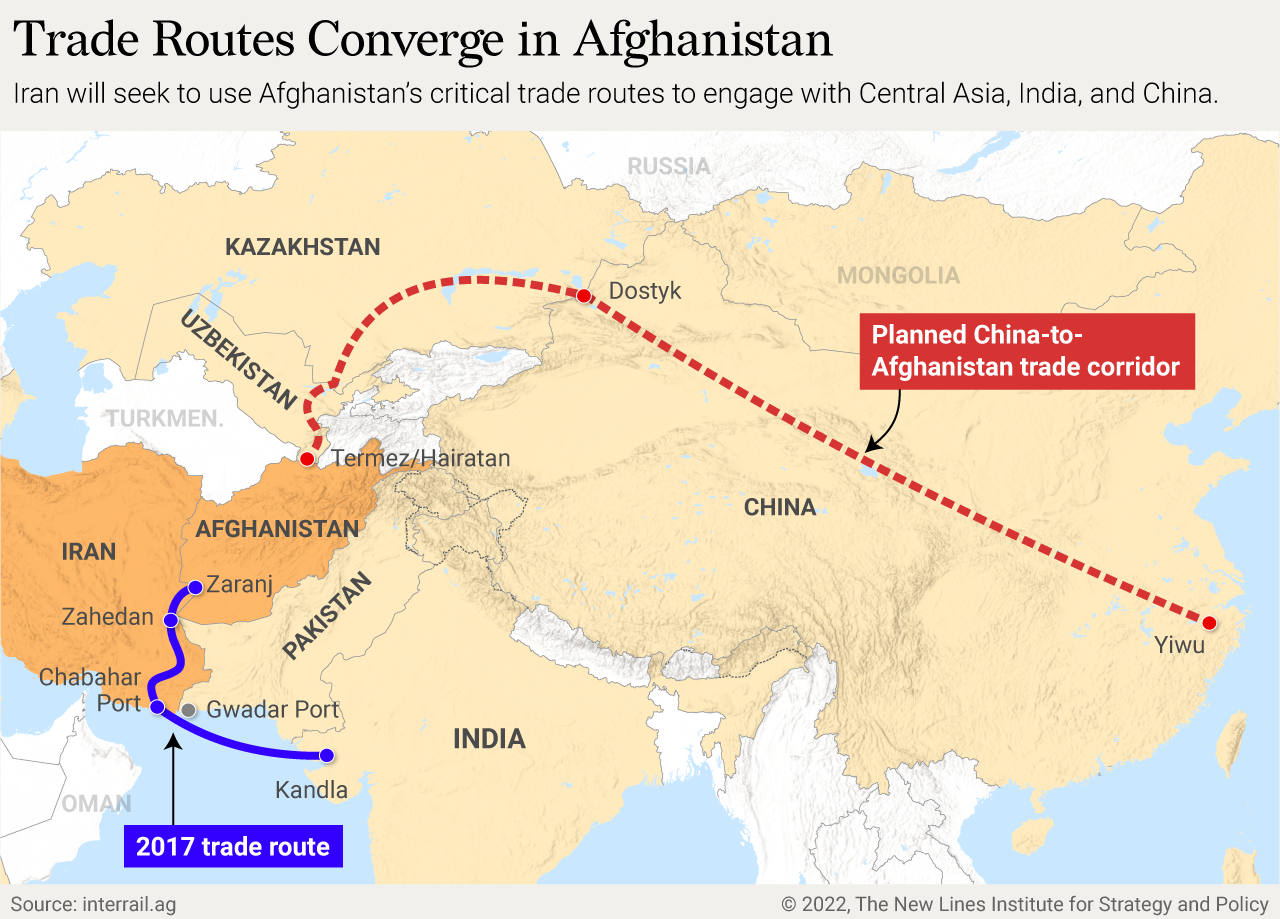
In January, Iran and China began the implementation of a 25-year strategic pact that is reported to include $400 billion of investment. China has also shown a willingness to import oil from Iran despite the reimposition of U.S. sanctions. Last year alone, China imported at least 590,000 barrels of Iranian oil daily. Iran desires to keep increasing its engagement with China, to counteract western sanctions and pressure, and Central Asia presents a pathway to further engagement. Central Asia has over 2,000 miles of border with China and is a region where Chinese trade is expected to expand.
Given how its economy has been battered by Western sanctions, Iran is limited in how much it can unilaterally offer the Central Asian states. Nonetheless, it has managed to make some significant strides in its economic engagement with both Tajikistan and Uzbekistan. Tajikistan is a natural economic partner for Iran given the commonality of Tajiki Persian with the Persian spoken in Iran, and as such, Iranian contractors have often conducted infrastructure projects in Tajikistan. In one multi-billion-dollar construction project, Iran built the Anzob Tunnel, which dramatically cuts travel time between Tajikistan’s capital, Dushanbe, and its second-largest city, Khujand. Iranian contractors constructed Tajikistan’s 220-megawatt Sangtuda-2 hydroelectric power plant in 2019, and Iran has begun to construct another power plant at Tajikistan’s Rogun Dam.
Iran has similarly made strides in its trade with Uzbekistan. Despite the Trump administration’s reimposition of sanctions, in 2018 bilateral trade between Iran and Uzbekistan grew by 40%. This January, Uzbekistan and Iran further cemented economic ties signing by an agreement that grants Uzbekistan access to Iran’s Chabahar port. As Iran pursues openings for economic growth, integration with Central Asia will continue to offer compelling opportunities.
Regional Stability
Iran also has an interest in maintaining stability in Central Asia. The instability in neighboring Afghanistan has caused millions of Afghans to seek refuge in Iran, at an estimated cost of billions of dollars per year. The crisis, which has already proven challenging for Tehran to manage, was only exacerbated by the U.S. withdrawal, so any increase in refugee flows could prove costly.
Central Asian states have similar concerns regarding the Afghan refugee crisis. Uzbekistan has expressly forbidden Afghan refugees, even going as far as cooperating with the Taliban to prevent an influx of refugees. Containing the refugee crisis is a point of common interest that will likely foster cooperation between Iran and Central Asian states and could serve as a foundation for further diplomatic, security, and economic engagement.
Iran has also already taken several steps to promote stability in Central Asia. In April, Iran and Tajikistan established a joint military committee, which Tajikistan hopes will increase regional cooperation to combat terrorism. Iran also hosted a conference in October with the foreign ministers of Afghanistan’s neighboring countries, including Tajikistan, Uzbekistan, and Turkmenistan, during which Tajikistan’s foreign minister raised concerns about “terrorists” gathering in northern Afghanistan and Uzbekistan’s foreign minister warned against isolating Afghanistan. Iran shares many of the Central Asian states’ concerns about Afghanistan and will seek to continue to engage with them to increase Central Asian stability.
Proxies
A third way Iran may seek to advance its interests is by expanding its proxy network into Central Asia. Establishing proxy forces in Central Asia would not signal a pivot away from Iran’s commitment to its forces in the Middle East. On the contrary, establishing proxies in Central Asia could open up new ways to support and reinforce its forces. Iran has already established a proxy force, the Fatemiyoun Brigade, on Central Asia’s doorstep in Afghanistan, which provides insight into why Iran would pursue the establishment of proxy forces in Central Asia.
The brigade, estimated at 30,000 to 60,000 fighters, is made up of the often-oppressed Shiite Hazara minority that accounts for 9 to 10% of Afghanistan’s population. Iran offered these fighters and their families, many of whom had fled to Iran as refugees, payment and citizenship, after which they were armed and trained by the Iranian Revolutionary Guard Corps. Iran initially did not use the Fatemiyoun for operations in Afghanistan; instead, since 2013, Iran has deployed an estimated 50,000 Fatemiyoun fighters to fight alongside its other proxy forces in Syria. After the withdrawal of U.S. forces from Afghanistan, however, Iran, seeking to secure its interests in post-withdrawal Afghanistan, began sending Fatemiyoun fighters back to Afghanistan.
The exact number of Fatemiyoun forces sent back to Afghanistan is unclear, but it was reported in 2020 that there were already roughly 3,000 fighters in the country. Thus far, the Fatemiyoun has chosen not to conduct attacks against the Taliban, but if relations between Iran and the Taliban were to sour, Iran could seek to exert pressure with its Fatemiyoun proxy forces. Iran may similarly try to establish groups like the Fatemiyoun in Central Asian countries to provide it with increased flexibility to pursue its security interests in Central Asia and beyond.
Obstacles to Engagement
Iran’s primary obstacle for economic engagement with Central and East Asia is U.S. sanctions. The complicated nature of attempting to trade with Iran can make other trade routes, like the Trans-Caspian Transport Route, which travels from Kazakhstan through the Caucasus to Turkey, more appealing alternatives for Central Asian states. U.S. sanctions have resulted in Indian firms repeatedly delaying development projects for Iran’s critical Chabahar port.
Chinese firms have taken over some of the projects that Indian firms delayed, and Iran may also be able to leverage China’s engagement to pressure India to oppose U.S. sanctions, as India does not want to lose out on access to Central Asia after its years of investment in Chabahar.
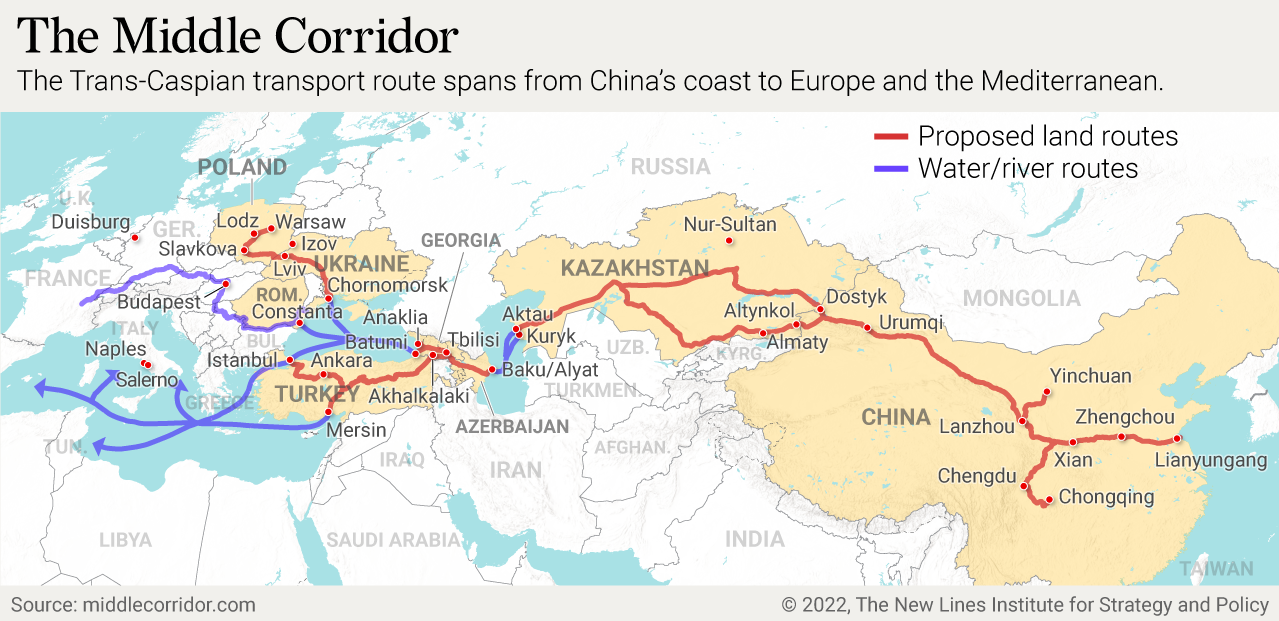
Another obstacle for Iran, particularly for cooperation in the political and security spheres, is its identity as an Islamic Republic. The Central Asian republics, all with secular governments, have had to contend with political Islam since independence. Just a year after its independence in 1991, Tajikistan fell into a civil war where the largest opposition party, the Islamic Renaissance Party, called for a government founded on Islamic values. This war was incredibly costly, with up to 60,000 people being killed in just the first year of the five-year conflict. Memories of this conflict, along with more contemporary conflicts in Central Asia with radical groups like the Islamic Movement of Uzbekistan, make Central Asian countries wary of partnering with countries like Iran that promote Islamic governance.
Nonetheless, most of the Islamic movements that threaten Central Asian states are Sunni extremist groups that oppose Iran’s Shiite ideology. In its past engagements in Iraq, Iran took advantage of the rise of Sunni extremism in the form of the Islamic State group to integrate its proxies like Asaib Ahl al Haq and the Badr Organization into the Iraqi government-funded Popular Mobilization Forces (PMF), which were in need of assistance in the fight against ISIS. Iranian proxies quickly became some of the largest militias in the PMF and established significant influence while fighting ISIS. Iran then used this influence to establish its supporters from some of these proxies in government positions in Iraq. During the rise of ISIS, Iraq had to focus on the preeminent threat of Sunni extremism, forcing it to temporarily put aside its concerns about Iranian infiltration.
In Central Asia, a similar situation could occur, especially if Islamic State Khorasan (IS-K), which claims territories in Iran and Central Asia, grows into a more serious threat to Central Asian stability. The religious demographics in Central Asia are certainly not as favorable to Iranian infiltration as Iraq’s. Central Asia is only about 1% Shiite, while in Iraq the Shiite population is upwards of 60%. Nonetheless, some Central Asian countries have significant Persian-speaking Tajik populations, who Iran may have an easier time engaging with. Tajikistan is roughly 85% Tajik, while in Uzbekistan, estimates regarding the Tajik population range from just around 1.5 million to as many as 9 million.
While Central Asian states may not want to turn to Iran and its proxies like the Fatemiyoun, in a moment of crisis they may have few other options. The withdrawal of U.S. troops from Afghanistan, Russia’s preoccupation with the situation in Ukraine, and China’s hesitancy to interfere in other countries’ domestic conflicts leaves Central Asia with few other countries to turn to if conflict with groups like IS-K escalates. Instability in neighboring Afghanistan represents the most immediate security threat to the Central Asian states, and while many Central Asian countries are trying to maintain good ties with the U.S., if Washington continues to be disinterested in assisting them, Central Asian states may be forced explore other options for their security needs.
Conclusions
Iran has major ambitions to use Afghanistan as a launching point for expanding its influence into Central Asia, but it faces several constraints. Tehran first would have to maintain a stable working relationship with the Taliban, a difficult prospect as different Taliban factions – some friendly to Iran and some more hostile – continue to vie for control in Afghanistan. Iranian and Taliban forces even engaged in clashes in December, and while this incident was quickly labeled a “misunderstanding,” future clashes could have the potential to escalate. Furthermore, Iran’s economy is still suffering from the effects of Western sanctions and the challenges of the pandemic, so its financial resources also present a limiting factor. Nonetheless, Iran has often proven its ability to extend its influence despite its lesser resources, and if the right opportunities continue to present themselves, Iran will surely seek to take advantage.
An Iran that is integrated with Central Asia should be a critical concern for the United States as it could weaken U.S. sanctions pressure on Iran and could create new security concerns. To combat this, the U.S. must support viable alternatives that address Central Asia’s economic and security concerns. Since the withdrawal from Afghanistan, U.S. resources and credibility in Central Asia are undoubtedly limited.
A potential option for U.S. engagement, however, is partnering with the newly renamed Organization of Turkic States, which includes all the Central Asian states except for Tajikistan, along with Turkey and Azerbaijan, to strengthen the alternatives to engaging with Iran. The organization has emphasized the need to combat terrorism in Afghanistan and has pursued projects to develop the Trans-Caspian Corridor. The organization has also stated that it is ready to “establish partnership relations with all countries,” leaving the door open to opportunities with the U.S. While the ability of the Organization of Turkic States to accomplish its projects is still unproven, it has strong cooperative diplomatic foundations that make it a good option for engagement while the U.S. attempts to reestablish its own credibility in Central Asia.
Daniel Turner is an Intern for the Power Vacuums Program in the Human Security Unit. He is currently in his senior year at the George Washington University studying Middle East Studies and Economics. Having studied both the Turkish and Persian languages he has a special interest in the domestic and foreign affairs of Turkey and Iran.
The views expressed in this article are those of the author and not an official policy or position of the New Lines Institute.

